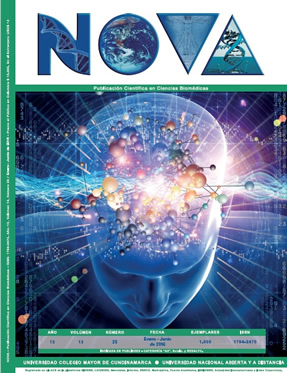Actividad antibacteriana y antioxidante de Baccharis revoluta Kunth
Antibacterial and Antioxidant Activity of Baccharis revoluta Kunth
Mostrar biografía de los autores
Objetivo: Evaluar la actividad antibacteriana y antioxidante de las partes aéreas de Baccharis revoluta. Métodos: La especie fue colectada en el municipio de Chocontá, Cundinamarca (N 05° 08’ 26,3” W 73° 38’ 59,2”). A los extractos de hojas, tallos y flores de diferente polaridad se les determinó la actividad antibacteriana frente a los microorganismos Staphylococcus aureus Gram (+), Klebsiella pneumoniae Gram (–) y Escherichia coli Gram (–), utilizando el método de difusión en gel por perforación en placa y se le evaluó la actividad antioxidante por el método DPPH•. Resultados: Las pruebas de eficacia antimicrobiana exhibieron inhibición significativa de los extractos. Además, se determinó la concentración crítica, que representa una medida de la susceptibilidad del microorganismo, y los extractos presentaron mayor actividad antibacteriana frente a Staphylococcus aureus que a Klebsiella pneumoniae y Escherichia coli. Los extractos etanólicos presentaron una actividad antioxidante representativa, con una IC50 y actividad antioxidante relativa de 7,2% y 43.64%, para el extracto etanólico de hojas, 6,95% y 45.57% para el extracto etanólico de tallos y 7,1% y 44.16 % para el extracto etanólico de flores, lo que nos determina una gran potencialidad de estos extractos etanólicos.
Visitas del artículo 208 | Visitas PDF 135
Descargas
- Ariza Espinar L. Las especies de Baccharis (Compositae) de Argentina central. Boletin de la Academia Nacional de Ciencias, 1973; 50(1-4): 175-305.
- Cuatrecasas José, Prima Flora Colombiana. COMPOSITAE – ASTEREAE. Instituto Botánico de la Universitaria; 1969: 233-299.
- Bremer K. Asteraceae: cladistics and classification. Portland, Oregon. Timber Press; 1994.
- Cuatrecasas J. Miscellaneous notes on Neotropical Flora, XV. New taxa in the Astereae Phytologia, 1982; 52: 166-177. 5. Arriaga-Giner, F. J., E. Wollenweber, I. Schober, P. Dostal and S. Braunt, 2β-Hydroxyhautriwaic acid, a clerodane type diterpenoid and other terpenoids from three Baccharis species Phytochemystry. 1986; 25(3): 719-721.
- Bohlmann Ferdinand, Banerjee Shanta, Jakupovic Jasmin, Grenz Michael, Misra Laxmi N., Schmeda-Hirschmann Guillermo, King Robert M. and Robinson Harold, Clerodane and labdane diterpenoids from Baccharis species Phytochemystry, 1985; 24(3): 511-515.
- Bohlmann Ferdinand, Zdero Christa, King Robert M. and Robinson Harold, Kingidiol, a kolavane derivative from Baccharis kingii Phytochemystry, 1984; 23(7): 1511-1512. 8. Bohlmann,Ferdinand Scheidges Cornelius, Zdero Christa, King Robert M. and Robinson Harold, Ent-Labdanes from Baccharis Sternbergiana Phytochemystry, 1984; 23(5): 1109. 9. Bruce B. Jarvis, Norman B. Pena, S. Nilgün Cömezó lu and M. Madhusudana Rao, Non-trichothecenes from baccharis megapotamica Phytochemystry. 1986; 25(2): 533-535. 10. Faini Francesca, Rivera Patricio, Mahú Manuel and Castillo Mariano, Neo-clerodane diterpenoids and other constituents from Baccharis species Phytochemistry, 1987; 26(12): 3281-3283. 11. Gambaro Vicente, Chamy María C. and Garbarino Juan A. Neo-clerodane diterpenoids from Baccharis macraei, Phytochemystry, 1987; 26(2): 475-477.
- Gambaro Vicente, Chamy María C., Garbarino Juan A., SanMartin Aurelio and Castillo Mariano, Neo-clerodane diterpenoids from Baccharis macraei, Phytochemystry, 1986: 25(9): 2175-2177.
- Givovich Arturo, San-Martín Aurelio and Castillo Mariano, Neo-clerodane diterpenoids from Baccharis incarum Phytochemystry, 1986; 25(12): 2829-2831.
- Thais Maira A. Biondo, Mirtes M. Tanae, Eliana Della Coletta, María Teresa R. Lima-Landman, Antonio J. Lapa, Caden Souccar June. Antisecretory actions of Baccharis trimera (Less.) DC aqueous extract and isolated compounds: Analysis of underlying mechanisms Journal of Ethnopharmacology, 2011; 136(2): 368-373.
- Rodrígues Carmem R.F., Dias Jacqueline H., Semedo Juliane G., da Silva Juliana, Ferraz Alexandre B.F., Picada Jaqueline N., Mutagenic and genotoxic effects of Baccharis dracunculifolia (D.C.) Journal of Ethnopharmacology, 2009; 124(2): 321-324. 16. Da Cruz Pádua Bruno, Silva Lucas Dornela, Rossoni Joamyr Victor Júnior, Humberto Jorge Luiz, Martins Chaves Míriam, Silva Marcelo Eustáquio, Pedrosa Maria Lucia, Caldeira Costa Daniela, Antioxidant properties of Baccharis trimera in the neutrophils of Fisher rats Journal of Ethnopharmacology, 2010; 129(3): 285-420. 17. Xavier V.B., Vargas R.M.F., Cassel E., Lucas A.M., Santos
- M.A., Mondin C.A., Santarem E.R., Astarita L. Sartor V., T., Mathematical modeling for extraction of essential oil from Baccharis spp. by steam distillation Industrial Crops and Products, 2011; 33(3): 599-604.
- Egly Feresin Gabriela, Tapia Alejandro, Gimenez Antonio, Gutierrez Ravelo Angel, Zacchino Susana, Sortino Maximiliano, Schmeda-Hirschmann Guillermo, Constituents of the Argentinian medicinal plant Baccharis grisebachii and their antimicrobial activity Journal of Ethnopharmacology, 2003; 89(1): 73-80.
- Cannel R., J.P., Natural Products Isolation. Humana Press, 1998: 472.
- Anderson, T. G. An evaluation antimicrobial susceptibility testing. In antimicrobial agents annal. New York, Plenum Press; 1961. 21. Barry, A. L. An improved single disk method for testing the antibiotic. Susceptibility of rapidly growing pathogens. Am. J. Clin. Pathol. 1970; 53: 149-158.
- Brand-WIlliams, W.; Cuvelier, M. E. and Berset, C. Use of a Free Radical Method to Evaluate Antioxidant Activity. Lebens. Wiss. U.Technol., 1995; 28: 25-30.
- Prior, R.L.; Wu, X. and Schaich, K. Standardized Methods for Determination of Antioxidant Capacity and Phenolics in Foods and Dietary Supplements. J. Agric. Food Chem. 2005; 53: 4290-4302.
- Suja, K.P.; Jayalekshmy, A. and Arumughuan, C. Free Radical Scavenging Behaviour of Antioxidant Compounds of Sesame (Sesame indicum L.) in DPPH• System. J. Agric. Food Chem. 2004;52: 912-915.
- Tapia Alejandro, Rodriguez Jaime, Theoduloz Cristina, Lopez Susana, Egly Feresin Gabriela, Schmeda-Hirschmann Guillermo, Free radical scavengers and antioxidants from Baccharis grisebachii Journal of Ethnopharmacology, 2004; 95(2): 155-161.
- Villano, D.; Fernández-Pachón, M.S.; Moyá, M.L.; Troncoso, A.M. and García-Padilla, M.C. Radical Scavening Ability of Polyphenolic Compounds Towards DPPH Free Radical. Talanta, 2007; 71: 230.
- Nausa, J. G. (2014). “Evaluación Clínica y radiográfica de injertos biocerámicos tipo Hidroxiapatita como alternativa en la reconstrucción de alveolos dentarios postexodoncia.”
- Galvez, Z. Y. A. and V. E. M. Burbano (2015). “Bacillus: género bacteriano que demuestra ser un importante solubilizador de fosfato.” NOVA Publicación en Ciencias Biomédicas. 29. Ramírez, L. C. C., et al. (2014). “Determinación de la presencia de bacterias patógenas para el humano en aguas de riego en la cuenca alta de la sabana de Bogotá; DC Colombia.” Nova 12(22).
- Corrales, L. C., et al. (2015). “Bacterias anaerobias: procesos que realizan y contribuyen a la sostenibilidad de la vida en el planeta.” Nova 13(24): 55-82.
- =========================================
- DOI: http://dx.doi.org/10.22490/24629448.1729









